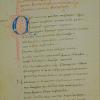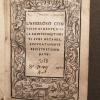A Copy of the Convivio (MS Ital. d 5)
Commentary
Tuscany? 1463
Paper; ff. 113; mm 288 x 198; prose and verses copied in a single column, in a humanistic minuscule by one hand. Some marginal corrections and notes, probably by the scribe. On f. 45v a note and a manicula (pointing hand) by another 15th c. hand. Stains and sketchy pen drawings on some pages (by a child?). On f. 1v, two notes on P. Bonaparte, the second one by E. Moore. One page is missing between pp. 38 and 39, and two between pp. 109 and 110.
For the start of the Convivio, f. 2r, a 8-line ornamental initial [S] in gold on a ground of blue, red, and green, with white highlighting, and white vine-stem interlace (bianchi girari); in the lower margin, a matching border with white vine-stem interlace (bianchi girari) on a shaped ground of blue, red, and green with white higlighting, with central space in a wreath for a coat of arms. For the canzoni, 4-5-line plain initials in blue; for the book divisions, 3-4-line plain initials blue (missing for books 1 and 2); for all other chapter divisions, plain initials in red in the margin adjacent to the text. Some rubrics, in red (from ch. I 6, irregular).
Antique parchment binding.
[Central Italy: Tuscany?]; Pierantonio di Benedetto Buonaparte (Florence, 16th c.); Bocca Bookshop in Rome (19th c.); E. Moore (Oxford, from June 1880); Bodleian Library (from 1916).
The manuscript is an example of the renewed interest in the Convivio in the second half of the fifteenth century when, in Florence particularly, Dante’s unfinished treatise captured the attention of Lorenzo de’ Medici and his intellectual circle. Like many codices of Dante’s minor works of this period, it is made of paper. It is not a luxury book, but its fairly good-quality decoration and the regular script point toward an upper-class readership.


